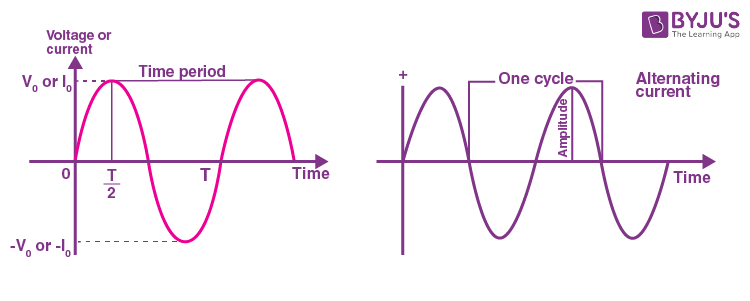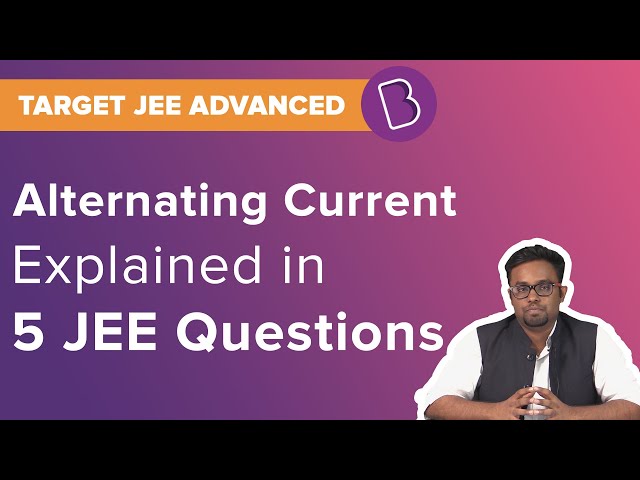Alternating current (A.C.) changes its magnitude and polarity at a regular interval of time. The time interval between a definite value of two successive cycles is the time period and the number of cycles or number of periods per second is frequency. The maximum displacement of the wave in both the directions is called the amplitude.
Alternating current can also be produced by different methods. One common method is by using a basic single coil AC generator, which consists of two-pole magnets and a single loop of wire having a rectangular shape. In a generator, mechanical energy gets converted into electrical energy.
Download Alternating Current Previous Year Solved Questions PDF
AC is the form of current that is mostly used in home appliances. Some of the examples of alternating current include audio signal, radio signal, etc.

JEE Main Previous Year Solved Questions on Alternating Current
Q1: A series AC circuit containing an inductor (20 mH), a capacitor (120 μF) and a resistor (60 Ω ) is driven by an AC source of 24 V/50 Hz. The energy dissipated in the circuit in 60 s is
(a) 3.39 × 103 J
(b) 5.65 × 102 J
(c) 2.26 × 103 J
(d) 5.17 × 102 J
Solution
Impedance,
Z = (R2 + (XC – XL)2)1/2
XL = ωL = (2πvL)
XL = 6.28 × 50 × 20 × 10–3 = 6.28 Ω
XC = (1/ωC) = 1/(2πvC) = 1/(6.28 x 120 x 10-6 x 50) = 26.54 Ω
XC – XL = 26.54 – 6.28 = 20.26
Z = ((60)2 + (20.26)2)½
Z2 = 4010 Ω2
Average power dissipated, Pav = ε rms Irmscos Φ
Pav = ε rms × (ε rms/Z) x (R/Z)
Pav = (ε rms 2/Z2) x R = [(24)2/4010] x 60 W = 8.62 W
Energy dissipated in 60 S = 8.62 x 60 = 5.17 x 102 J
Answer: (d) 5.17 x 102 J
Q2: In an AC generator, a coil with N turns, all of the same area A and total resistance R, rotates with frequency ω in a magnetic field B. The maximum value of emf generated in the coil is
(a) NAB
(b) NABR
(c) NABω
(d) NABRc
Answer: (c) In an a.c. generator, maximum emf = NABω
Q3: The phase difference between the alternating current and emf is π/2. Which of the following cannot be the constituent of the circuit?
(a) LC
(b) L alone
(c) C alone
(d) R, L
Solution
R and L cause phase difference to lie between 0 and π/2 but never 0 and π/2 at extremities
Answer: (d) R, L
Q4: Alternating current cannot be measured by D.C ammeter because
(a) A.C cannot pass through D.C ammeter
(b) A.C changes direction
(c) The average value of current for the complete cycle is zero
(d) D.C. ammeter will get damaged
Solution
The average value of A.C for the complete cycle is zero. Hence A.C cannot be measured by D.C ammeter
Answer: (c) The average value of current for the complete cycle is zero
Q5: A power transmission line feeds input power at 2300 V to a step-down transformer with its primary windings having 4000 turns. The output power is delivered at 230 V by the transformer. If the current in the primary of the transformer is 5 A and its efficiency is 90%, the output current would be
(a) 25 A
(b) 50 A
(c) 45 A
(d) 35 A
Solution
Given єp = 2300 V, Np = 4000
єs = 230 V,
Ip = 5 A,
η = 90% = 0.9
η = Po/Pi = (єsIs)/(єpIp)
Is = ηєpIp/єs = (0.9 x 2300 x 5)/230 = 45 A
Answer: (c) 45 A
Q6: A circuit connected to an ac source of emf e = e0 sin(100 t) with t in seconds, gives a phase difference of π/4 between the emf e and current I. Which of the following circuits will exhibit this?
(a) RC circuit with R = 1 kΩ and C = 10μF
(b) RL circuit with R = 1 kΩ and L = 10mH
(c) RC circuit with R = 1 kΩ and C = 1μF
(d) RL circuit with R = 1 kΩ and L = 1mH
Solution
Xc = R
1/ωC = R
ω = 100 rad/s
Therefore, 1/100 = RC
Substituting values from option (a)
R = 1 kΩ = 103 Ω
C = 10μF = 10 x 10-6 F
RC = 103 x 10 x 10-6 = 1/100
Therefore, option (a) is correct
Answer (a) RC circuit with R = 1 kΩ and C = 10μF
Q7: In an a.c. circuit, the instantaneous e.m.f. and current is given by
e = 100sin30t, i = 20sin(30t – π/4)
In one cycle of A.C, the average power consumed by the circuit and the wattless current are, respectively
(a) 50, 10
(b) 1000/√2 ,10
(c) 50/√2, 0
(d) 50, 0
Solution
Pavg = VrmsIrmscosθ
Pavg = (V0/√2) (I0/√2)cosθ
= (100/√2) (20/√2)cos450
Pavg = 1000/√2 watt
Wattless current = Irmssinθ
Wattless current = (I0/√2)sinθ
= (20/√2)sin450
= 10 amp
Answer: (b) 1000/√2 ,10
Q8: A coil having n turns and resistance R Ω is connected with a galvanometer of resistance 4R Ω. This combination is moved in time t seconds from a magnetic field W1 weber to W2 weber. The induced current in the circuit is
(a) -(W2 – W1)/5Rnt
(b) -n(W2 – W1)/5Rt
(c) -(W2 – W1)/Rnt
(d) -(W2 – W1)/5Rnt
Solution
The emf induced in the coil is e = -n(dΦ/dt)
Induced current, I = e/R’ = – (n/R’)(dΦ/dt) ——(1)
Given, R’ = R + 4R = 5R
dΦ = W2 – W1
dt = t
(here, W1 and W2 are flux associated with one turn)
Substituting the given values in equa(1) we get
I = (-n/5R)(W2 – W1/t)
Answer: (b) -n(W2 – W1)/5Rt
Q9: An alternating voltage V(t) = 220 sin100πt volts is applied to a purely resistive load of 50 Ω. The time taken for the current to rise from half of the peak value is
(a) 5 ms
(b) 2.2 ms
(c) 7.2 ms
(d) 3.3 ms
Solution
As v(t) = 220 sin100πt
So I(t) = (220/50) sin100πt
I.e., I = Im = sin100πt
For I = Im
t1 = (π/2) x (1/100π) = (1/200) sec,
And for I = Im/2
⇒ (Im/2) = Imsin(100πt2)
⇒ (π/6) = 100πt2
⇒ t2= (1/600) s
∴ treq = (1/200) – (1/600) = (2/600) = (1/300)s =3.3 ms
Answer: (d) 3.3 ms
Q10: An arc lamp requires a direct current of 10A at 80V to function. If it is connected to a 220V (RMS), 50 Hz AC supply, the series inductor needed for it to work is close to
(a) 0.065 H
(b) 80 H
(c) 0.08 H
(d) 0.044 H
Solution
I = 10A
V = 80 V
R = 8 Ω
10 = 220/(82 + XL2)½
64 + XL2= 484
XL = √420
2π x 50L = √420
L = √420/100π
L = 0.065 H
Answer: (a) 0.065 H
Q11: In a series, LCR circuit R = 200Ω and the voltage and the frequency of the main supply is 220 V and 50 Hz respectively. On taking out the capacitance from the circuit the current lags behind the voltage by 300. The power dissipated in the LCR circuit is
(a) 242 W
(b) 305 W
(c) 210 W
(d) Zero
Solution
Tan Φ = (XL – Xc)/R
Tan 300 = Xc/R = Xc = R/√3
Tan 300 = XL/R = XL = R/√3
XL = Xc ⇒ Condition for resonance
So Φ = 00
P = VIcos00
P = V2/R = (220)2/200 = 242 W
Answer: (a) 242 W
Also Read:
Alternating Current JEE Advanced Previous Year Questions With Solutions
Alternating Current – JEE Advanced Solved Questions


Comments